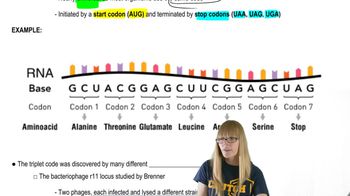Table of contents
- 1. Introduction to Genetics51m
- 2. Mendel's Laws of Inheritance3h 37m
- 3. Extensions to Mendelian Inheritance2h 41m
- 4. Genetic Mapping and Linkage2h 28m
- 5. Genetics of Bacteria and Viruses1h 21m
- 6. Chromosomal Variation1h 48m
- 7. DNA and Chromosome Structure56m
- 8. DNA Replication1h 10m
- 9. Mitosis and Meiosis1h 34m
- 10. Transcription1h 0m
- 11. Translation58m
- 12. Gene Regulation in Prokaryotes1h 19m
- 13. Gene Regulation in Eukaryotes44m
- 14. Genetic Control of Development44m
- 15. Genomes and Genomics1h 50m
- 16. Transposable Elements47m
- 17. Mutation, Repair, and Recombination1h 6m
- 18. Molecular Genetic Tools19m
- 19. Cancer Genetics29m
- 20. Quantitative Genetics1h 26m
- 21. Population Genetics50m
- 22. Evolutionary Genetics29m
11. Translation
The Genetic Code
Problem 24b
Textbook Question
Har Gobind Khorana and his colleagues performed numerous experiments translating synthetic mRNAs. In one experiment, an mRNA molecule with a repeating UG dinucleotide sequence was assembled and translated.
If the genetic code were a doublet code instead of a triplet code, how would the result of this experiment be different?
 Verified step by step guidance
Verified step by step guidance1
<span>Understand the concept of the genetic code: The genetic code is a set of rules by which information encoded in mRNA sequences is translated into proteins by living cells. In the standard genetic code, a triplet of nucleotides (codon) specifies a single amino acid.</span>
<span>Consider the implications of a doublet code: If the genetic code were a doublet code, each codon would consist of two nucleotides instead of three. This would significantly alter the way mRNA sequences are translated into proteins.</span>
<span>Analyze the repeating UG dinucleotide sequence: In the given experiment, the mRNA sequence is a repeating UG pattern. In a triplet code, this sequence would be read as UGU GUG UGU GUG, etc., potentially coding for a specific sequence of amino acids.</span>
<span>Predict the translation outcome with a doublet code: With a doublet code, the repeating UG sequence would be read as UG UG UG UG, etc. This would result in a different set of codons and, consequently, a different sequence of amino acids.</span>
<span>Consider the diversity of possible proteins: A doublet code would have only 16 possible codons (4^2), compared to 64 possible codons (4^3) in a triplet code. This would limit the diversity of proteins that could be synthesized, as fewer amino acids could be specified.</span>
Recommended similar problem, with video answer:
 Verified Solution
Verified SolutionThis video solution was recommended by our tutors as helpful for the problem above
Video duration:
1mPlay a video:
Was this helpful?
Key Concepts
Here are the essential concepts you must grasp in order to answer the question correctly.
Genetic Code
The genetic code is the set of rules by which information encoded in genetic material is translated into proteins. It consists of codons, which are sequences of three nucleotides that correspond to specific amino acids. Understanding the genetic code is crucial for interpreting how sequences of nucleotides dictate the synthesis of proteins.
Recommended video:
Guided course

The Genetic Code
Triplet Code vs. Doublet Code
The triplet code refers to the use of three nucleotides (codons) to specify each amino acid in protein synthesis, allowing for 64 possible combinations. In contrast, a doublet code would use pairs of nucleotides, resulting in only 16 combinations. This difference significantly impacts the complexity and diversity of proteins that can be synthesized.
Recommended video:
Guided course

The Genetic Code
Translation Process
Translation is the process by which ribosomes synthesize proteins using mRNA as a template. During translation, the ribosome reads the mRNA codons and assembles the corresponding amino acids into a polypeptide chain. The efficiency and accuracy of this process depend on the structure of the genetic code, which determines how sequences are interpreted.
Recommended video:
Guided course

mRNA Processing

 11:43m
11:43mWatch next
Master The Genetic Code with a bite sized video explanation from Kylia Goodner
Start learningRelated Videos
Related Practice

